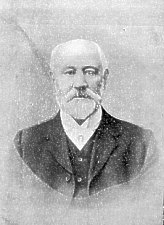
[From 1909 Examiner Annual]

THE MAYOR OF DOUGLAS.
THE Mayor of Douglas for 1908-1909 is Mr. ARTHUR HENRY MARSDEN, J.P, who, both on the occasion of his informal selection for the office and on that of his formal election to it, was the unanimous choice of the Town Council. Mr. Marsden, who is a licensed victualler, was born in Birmingham over fifty years ago, but in early infancy was removed to Manchester. His father, the late Mr. Joseph Marsden, subsequently became a member of the City Council of Cottonopolis. While the Mayor was still a school-boy he came with his parents to reside in Douglas, and became a pupil at the Douglas Grammar School — in those days known as the Middle School. Upon ending his school career he proceeded to Manchester, where he engaged for a period in business pursuits About three decades ago, however, be returned to Douglas to assist his father, who was getting on in years, in the conduct of the Douglas Head Hotel; and, upon his father's death, he succeeded to the control of the hotel. In 1898, he was elected to the Douglas Town Council as one of the members of St. George's Ward, and ever since he has sat as one of the representatives of this, the premier ward of the town. He is highly respected and esteemed by his fellow councillors. In his youth and early manhood, Mr. Marsden was a famous exponent of the Rugby code of football, and in the early'eighties he, with much acceptance and success, captained the Douglas Club. The Mayor is married, and his wife, a lady of most charming disposition, is sure to make an excellent Mayoress. 1909
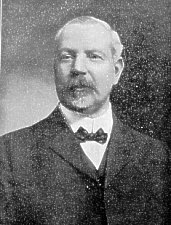
MR. WILLIAM M. CORKILL,
The Secretary and Manager of the Isle of Man Steam Packet Co., Ltd.
On the 27th August, 1908. Mr. William M. Corkill was appointed by the directors of the Isle of Man Steam Packet Company, Ltd, as Secretary and Manager of the Company, in succession to Mr. Thomas P. Ellison, who resigned in the early part of the month. The appointment was a most popular one, and it has been fully justified by results. Mr. Corkill, who is a Douglas man, entered the Company's service while a youth some 35 years ago. For about 30 years he was chief clerk under Mr. Ellison, so that he had ample opportunity — and he availed himself of it — to make himself fully acquainted with the details and ramifications of the largest and most important commercial concern in the Isle of Man. Mr. Corkill is a thorough man of business in that he combines ability and energy with courtesy and tact.
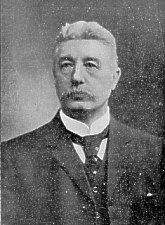
MR. JOSEPH PHILLIPS,
Chairman of the Douglas Board of Guardians.
MR. Phillips is not a Manxman, but he came to the Isle of Man nearly twenty years ago. For some years he has devoted a considerable part of his time to public work in his adopted country. At the last election of the Douglas Poor Law Guardians he was returned at the head of the poll, this being the first contested election for Poor Law Guardians under the Ballot Act. In April last he was elected Chairman of the Board. He is an ardent educationist, and has held a seat on the Douglas School Board for six years. For the past three years he has filled the responsible position of Chairman of the General Attendance Committee. In business he is a fancy goods dealer, being proprietor of the well-known Phillips' Bazaars.
The Mona A.F.C., Cleveland, Ohio, U.S.A.
The runners-up in the competition for the Bowler Cup were the Mona A.F.C. team, which is composed of Manxmen After a well-fought game, in the final round, Lorain just managed to beat the Manx-American players by a narrow margin of one goal to nothing. The Manxmen, according to the Cleveland newspapers, played plucky and clever football, and they appear to have had " hard lines" in not making the match a draw. It was within three minutes of time being called when the only goal was scored. The Manx team are described by one Press critic as being "far ahead of any that has ever booted the ball in this vicinity outside of the Corinthians." The photo. is by Mr. J. T. Kinnish, formerly of Douglas, and now of Cleveland.
Top Row, — Bert Kinnish, T. Watterson, J. Gregor, J. Clague,
D. Kelly, R. Anderson. R. McCaa.
Middle Row — G. Kinley (sec.), W. Corris, J. Watterson, R.
Crellin, J. Keig.
Bottom. Row — J. Corris, J. Gillespie, J. Bridson, T. Keig
(captain), W. Irwin, Malchom Anderson (mascot).
Members of Team not on photo — S. T. Kelly, W.. H. Castell. W. D. Cowley, R. S. Kelly and F. Scarff
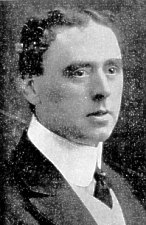
MR. FRANK COTTLE.
ALTHOUGH born in Liverpool, Mr. Cottle comes of a Manx family, both of his parents being natives of Douglas. Articled in 1893 to the engineer and surveyor to the West Derby Urban District Council, Mr. Cottle has had the advantage of considerable practical experience in municipal engineering and land surveying in connection with the Liverpool City Council, the Toxteth District Urban Council, and the County Borough of Salford Corporation. In 1902 he came as deputy to Mr. A. E. Prescott, the then Borough Surveyor, and, on the latter's appointment to Eastbourne, he was chosen to fill the position thus rendered vacant. Many important municipal works have been carried out since his appointment to Douglas, notably the sewerage works, the new reservoir, and the extension of the borough boundaries. He has had full responsibility, on behalf of the Council, for carrying out the Public Baths scheme. The preparation of the plans, etc., in connection with the proposed street improvement in Douglas, has also occupied the attention of the Borough Surveyor. Mr. Cottle is a member of the Municipal and County Engineers' Association, of the Royal Sanitary Institute, and also of the Liverpool Engineering Society.
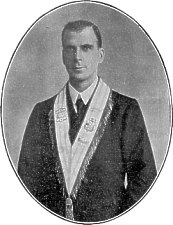
MR. JOHN CORKILL.
MR. JOHN CORKILL is a native of Douglas, in which town he carries on a successful ironmongery business. A life-long Rechabite, Mr. Corkill was, in April last, elevated to the highest position in Insular Rechabitism — that of District Chief Ruler.. He has taken a prominent part in temperance work among the young in connection with bands of hope, and for many years past he has occupied the position of assistant superintendent of the Rose Mount Sunday School. A public-spirited citizen, Mr. Corkill has displayed a deep interest in Poor Law administration, and for the past eight years he has been a member of the Douglas Poor Law Guardians. This year he has been appointed Chairman of the Finance Committee of the Board, that position carrying with it the vice-chairmanship of the Guardians. Mr. Corkill is interested in all movements having for object the encouragement of singing, and he is treasurer of the Douglas Male Voice Choir.
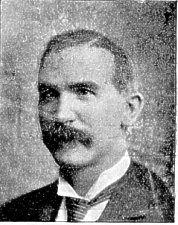
MR. JOHN HENRY COLLISTER,
PRESIDENT of Mona's Relief Society, Cleveland, Ohio, U.S.A., was born in the Isle of Man and went to Cleveland when a youth in his teens-nearly forty years ago. Beginning as an employee in a humble capacity of the firm in which he is now the managing director, he has developed into one of the most substantial business men of Cleveland. The Davis-Hunt-Collister Co., of which he is the most important personality, is one of the leading firms in hardware trade in the city, employing about 40 clerks and salesmen. Mr. Collister has, without question, the unique distinction of being personally acquainted with more people of Manx birth and descent residing in the United States than any other person in America. He is the present President of Mona's Relief Society, and he served the society as its treasurer for twenty five years. He is a director of the Cleveland Savings and Loan Co., as well as being considerably interested in real estate. Also is he a leading member of the Cleve-land Chamber of Commerce and of the Builders' Exchange, and treasurer of Mona's Mutual Benevolent Society. Mr. Collister lived at Kenna, Kirk German, up to the time of his leaving the Isle of Man. His father was Mr. Edward Collister, and he has also three brothers in Cleveland.
Mr. G. F. CLUCAS, H.K.
MR. George Frederick Clucas, H.K., comes of one of the oldest of Manx families,[see Clarke as father changed name] his ancestors being entered on the first Manorial Rolls as owners of the estate of Mary-voar, in Santon. His childhood was spent at Repton, Derbyshire He was educated at Repton School, whence he, in 1888, proceeded to Christ's College, Cambridge, taking his degree in 1891. He was called to the English Bar in 1894, and in 1895 was admitted a member of the Manx Bar Mr Clucas owns much land in the Isle of Man, and takes a deep interest in agriculture, he being one of the foremost members of the Isle of Man Farmers' Club, and president of the I.O. M. Agricultural Society for this year. He is also chairman of the Manx Music Festival Committee. At the last General Election (1908), he was. returned without opposition as one of the representatives of Middle Sheading for the House of Keys. Mr Clucas has literary and antiquarian tastes, and he actively concerns himself with social problems.
THE ISLE OF MAN STEAM PACKET,COMPANY'S FIRST STEAMER-" MONA'S ISLE" (1830). Length, 116 feet ; beam; 19 feet; depth, 10 feet; gross tonnage, 200.
TURBINE STEAMER " BEN-MY-CHREE."
THIS magnificent vessel-the latest addition to the Isle of Man Steam Packet Company's fleet-did good service during July and August, 1908. The "Ben-my-Chree" was designed and built by Vickers, Son, and Maxim, Barrow-in-Furness, and she is required to maintain in service a speed of 24 knots-a very exceptional speed in Channel service, and only excelled on the ocean by the "Mauretania" and "Lusitania." She will carry 2,500 passengers. Length overall, 390 ft. length between uprights, 375 ft. ; breadth, 46 ft. ; depth to main deck, 18 ft. 6 in. The vessel was under the command of Captain Keig, Commodore of the company's fleet; the chief engineer being Mr. J.R. Kelly.
BALLAUGH OLD CHURCH.
THIS church, which is dedicated to St. Mary, is rich in antiquarian interest. The western facade, architecturally quaint but very fine in design, is of Bishop Wilson's time, the sole survival of his church building. A number of runic crosses found about the church are preserved at the new parish church, built in 1833. The font is a most curious one, and was probably used for total immersion. In the churchyard there is an interesting runic cross, in a fine state of preservation, bearing the inscription " Thorlaibr Thariulb snnr raisti Krus Thano aiftir Ulb sun sin" which translated is "Thorlaf Thorogolfson erected this cross to his son Ulf." The church register is the oldest on the Island, commencing with the year 1598,
|
|
||
|
|
||
|
Any comments, errors or omissions
gratefully received The
Editor |
||